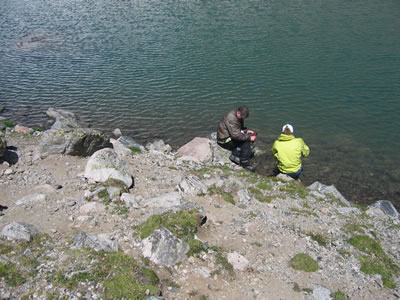| 271 | Hydration Lessons | 2010-08-23 |

Some years ago, two friends and I went to climb Stettner Ledges on Longs Peak. To get an early start we chose to bivouac (camp) near the base of the climb. We found a nice place to sleep with a creek a couple hundred feet away. It was idyllic.
After dinner we filtered water for the morning. I drank all that I could and filled everyone's containers. During the filtering process the filter clogged. I had learned how to quickly unclog the filter; but the process required taking the clogged device apart. In the dismantling process I lost a small rubber ball which acts as a valve for the filter. We searched for the ball; but it looked exactly like one of the gazillion of the pebbles which lined the creek bank. The search was useless. We were going to be without any extra water. We had however filled all of our containers and were not worried.
Come morning, I drank my water, to camel up (drinking more than normal amounts of water in the hopes of over-hydrating.) I only carried a small, pint bottle of water for the day. My friends carried more, but still not much. We made it to Broadway Ledge at the top of Stettner's in good time; but it was a hot, strenuous climb. We had great weather and lots of time to finish the climb by continuing to the summit via Kieners Route.
One of my friends began feeling ill, probably altitude sickness. On the upper part of the route we were having to pull him, a normally very strong climber, up each step. We needed to get him down, but the quickest way down was by going over the top. It was late afternoon before we summited.
We gave him the rest of our water, not much, and continued. The day tumbled into the night. We were going to go down a steep gully to our camp; but chose to walk all the way around Mount Lady Washington and then Chasm Lake to reach our camp on Mills Glacier. It maybe was not the best idea, but we were able to stay together, help each other along, and no one got lost or injured!
Arriving at our bivouac site late, we still did not have water, a filter, or chemicals. There was no way we could walk back to the trailhead that night. Sleep had become a second priority to us. As we pulled out our sleeping bags and pads we discussed our water dilemma. We all were willing to drink the unfiltered water. Bacteria and parasites were not a concern. If we did not drink, we were going to be hurting.
In the morning we quickly packed and walked safely down the hill six miles to the trailhead. We were hungry; but at least we had water to drink.
Luckily, no one got sick from the water.
A few notes ...
- We still try to drink all the water we can the night before and the morning of a big hike or climb.
- We do not like to carry a lot of water with us. We carry a filter or chemicals instead.
- Amy generally needs more water than I do. No, two people have the same needs.
- Now, we always carry chemical water treatment tablets, even if we pack a filter. The tablets stay in our emergency kits.
- I soon replaced the filter, purchasing a more clog resistant and field maintainable unit.
- The lack of water contributed to our friends altitude sickness.
- With hindsight we saw that if we had drank unfiltered water from a couple of other locations (Boulderfield and the outlet of Chasm Lake) we would have been stronger and might have been able to walk out that night.
- Now days we usually use small hydration bladders (50oz) in our packs and also carry one or two small collapsible water bottles. When we stop for a break we like to really drink water not sip it through a straw.
- I never run out of water (unless I give it away). I might be thirsty, but I automatically start rationing my supply.
- Always filter or treat your backcountry water. It lessens the chances of getting sick.
- In the outdoors you often have to make decisions with consequences. Make them wisely by consulting with your partners and weighing all of the options.
Happy hydrating trails.